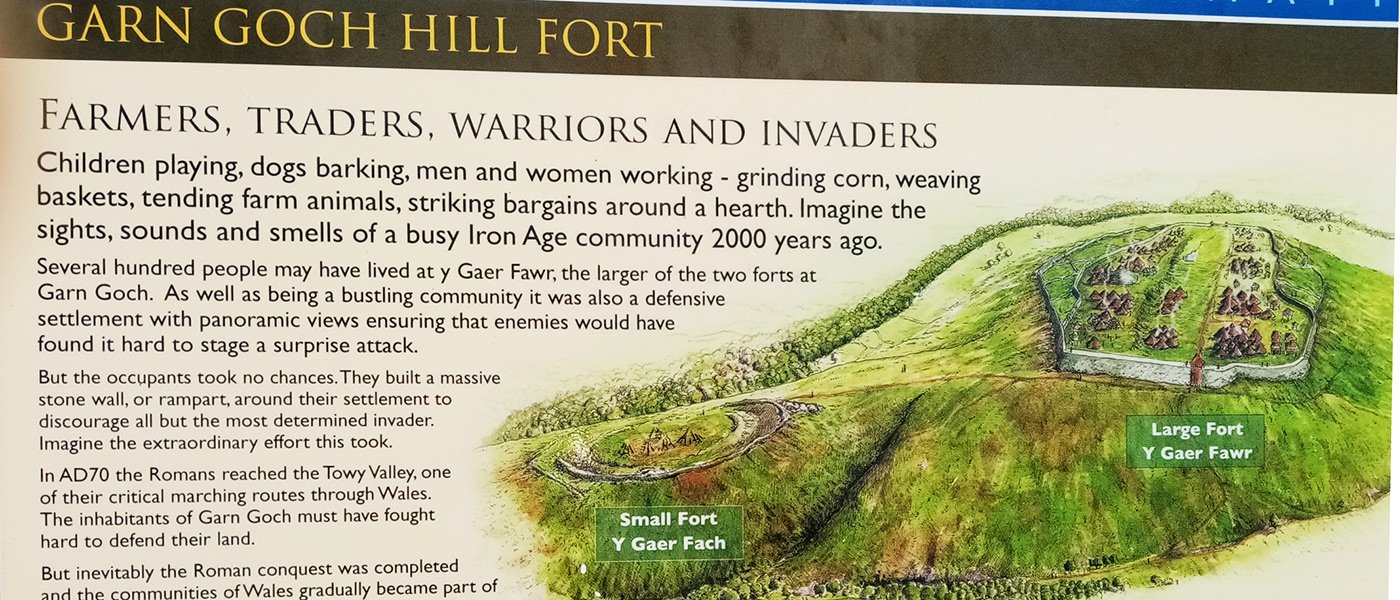A Mythical Iron Age Settlement?
Brecon Beacons National Park Authority (despite much publicity about changing the name to Bannau Brycheiniog, it's primary website is, sensibly, still breconbeacons.org, and it still calls itself Brecon Beacons National Park Authority) is to be congratulated for investing in making Garn Goch as accessible to the public as possible by ensuring there is online information and road signage, building a car park, producing an impressive information board, keeping prime areas free of saplings and bracken, maintaining and opening up footpaths, holding community meetings and communicating with local people.
And, as the last expert report on Garn Goch (albeit produced nearly 50 years ago) concluded that it was an Iron Age hillfort, BBNP is absolutely right in treating it as no more than one of about 700 Iron Age forts in Wales.
That's why the information board at the Garn Goch car park has an evocative story about Garn Goch being a healthy, happy Iron Age village, and got a good illustration to visualise the idea.
We don't seek to be contrarian, but there's an argument that it's poor history and worse archaeology, though that's not BBNP's fault as they are 'following the science'.
However, Iron Age forts in Wales fall broadly into three categories: small earthworks forts on steep sided hills with multiple rings of banks and ditches; promontory forts above sea cliffs; large forts with massive, still visible smooth sided walls and ramparts, such as Tre'r Ceiri and Garn Boduan.
Garn Goch could only belong to the third category, but its 'walls' offer no evidence of such massive walls or ramparts, and even the strengthened western wall is a pile of stones that could never have been a proper wall with ramparts. At most, it was an Iron Age folly intended to scare off invaders coming up the Tywi valley.
So if not an Iron Age fort, how about an Iron Age settlement?
At the recently excavated Wittenden Clumps in Oxfordshire, for example, the 'substantial iron age settlement...[was] at the foot of...an enormous hillfort' (ie not within the fort), and, similarly, Coflein says nothing about a Garn Goch settlement within the linear cairn, but does say that 'on the southern side are a series of enclosures and roundhouses which may be farmsteads of prehistoric age'.
Of course, there are Iron Age hillforts with settlements within their walls, but no evidence that this is one of them. Even if there had been, it is highly unlikely to have have had 'several hundred' inhabitants: Wittenden Clumps was a 'substantial' Iron Age settlement, but only had a dozen or so roundhouses.
BBNP, however, is alone in not even mentioning the significantly more ancient - and much more interesting - origins of Garn Goch. There is a strong argument to be made that large Iron Age forts often have Neolithic origins because they began as large scale causewayed enclosures or henges for religious purposes: Garn Boduan, Tre'r Ceiri and Caerau are three such examples.
It can also be argued that some locations like Wooltack Point (Deer Park) in Pembrokshire and Garn Goch are two examples of Neolithic religious sites that never were Iron Age forts or 'defensive enclosures', despite that being their official designation.
It's excellent that BBNPA wants to tell a story that appeals to prospective visitors, but why not tell a story that would make it significantly more appealing?
That's why we're confident BBNPA will want to support initiatives to gain funding for a project to produce evidence that would make it a more visited and more valuable property in line with its Statutory Purposes and Duty.
Let's put it this way: which would you be more likely to visit, one of about 700 Welsh Iron Age hillforts, or The Largest Ancient Stone Monument In Britain?






